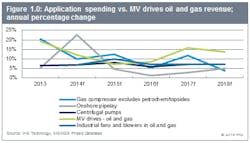In 2014, oil and gas spending growth rates are slowing across the industry's subsectors (upstream, midstream, downstream, offshore, and liquefied natural gas [LNG]). IHS predicts this will persist through 2018 and will result in a shift in growth leadership away from the upstream and midstream subsectors towards the downstream, offshore and LNG subsectors. Although spend growth rates are predicted to be lower, they will provide a sustainable source of demand for industrial automation products, in particular for low-voltage (LV) and medium voltage (MV) drives.
As unconventional oil and gas upstream activity set the onshore subsectors in motion, a recent slowdown in upstream activity is predicted to result in slower growth rates from 2014 to 2016 as midstream-dependent pipelay capex declines. Onshore pipelay, as shown in Figure 1, represents forecast capital oil and gas expenditure and may augur a slowdown in 2015 and 2016. Upstream activity in North America has slowed primarily because gas prices have remained below $5 per MMBtu for several years now; the price of natural gas in North America (Henry Hub Pricing) went from $10 per MMBtu to around $4 per MMBtu as natural gas production increased (see Figure 2). With fewer higher price LNG export destinations, natural gas drilling activity in North America has declined and shifted towards exploration for oil and natural gas deposits rich in natural gas liquids (NGLs), while many other types of wells are being plugged up and closed.
The United States’ ambiguous stance on exports of LNG to countries without a free trade agreement (FTA) and the long approval process are limiting upstream activity due to their indirect effect on a much lower domestic natural gas price. The combined approval process for the Department of Energy (DOE) and Federal Energy Regulatory Commission (FERC) to export to non-FTA countries took more than 700 days for several completed LNG projects. LNG projects for FTA countries take about a month, with five additional FTA countries planning to add import capacity: Colombia, Panama, Bahrain, Jordan, and Morocco. Future approvals are important for further LNG and oil and gas investment because non-FTA countries are estimated to have imported 78% of LNG volume in 2013, according to IHS Energy. By obtaining access to higher-priced natural gas markets outside of the United States, more upstream plays are profitable and investment may increase dramatically.
According to dedicated research on the oil and gas markets for LV and MV motor drives, more than $1 billion of motor drives were sold into the oil and gas industry in 2013. The subsector shift in spending discussed above will have varied effects for the LV and MV drives by subsector. LV drives are used where space is at a premium in upstream applications, such as on hydraulic fracturing skids and offshore on rigs and FPSOs. MV drives are used more for high voltage and power applications in midstream and LNG subsectors, such as for natural gas compression and liquefaction but also for larger pumps. Since more than half of the revenues for MV drives came from the midstream subsector in 2013, a slowdown will affect MV drives more than LV drives (which are sold more evenly across subsectors). Strength in offshore oil and gas will result in more LV drive demand relative to MV drives.

